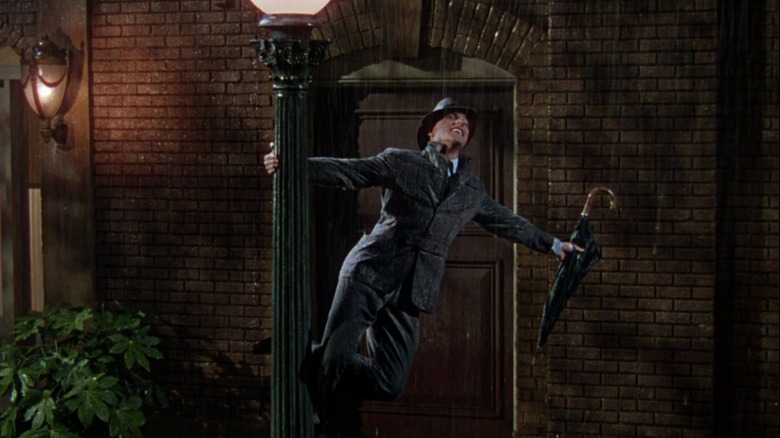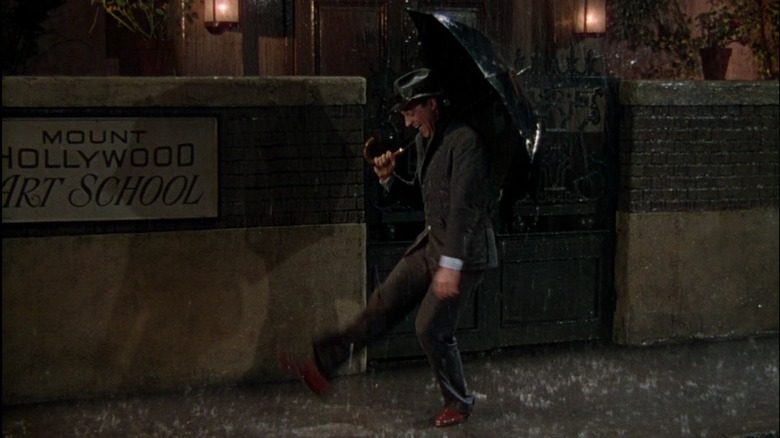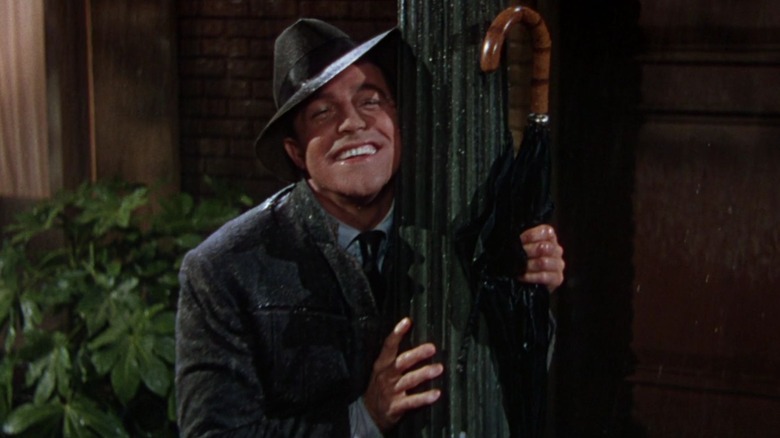No, They Didn't Dance In Milk On The Set Of Singin' In The Rain
I have been living a lie. To be fair to myself, I didn't know I was living a lie, but I was. When I was a teenager, I got really into classic Hollywood cinema, as many of us movie lovers do. Pretty early in my cinematic education I watched Stanley Donen and Gene Kelly's 1952 movie musical "Singin' in the Rain." You look at any list compiling the best films of all time, and it will inevitably be on it. The Sight & Sound poll listed it as the 20th best film of all time. The American Film Institute goes even further and ranks it at No. 5. I cannot deny that it belongs on the lists. Every time I watch it, I am utterly spellbound by its charm.
If you are a young cinephile who loves "Singin' in the Rain," you will unquestionably be told a piece of trivia by someone about the film's production that has frankly become pretty common knowledge at this point. You will be informed that because photographing rain is notoriously difficult to capture clearly, they had to use milk for the titular musical number's rain. It's one of those fun nuggets that shows off the ingenuity of filmmaking, doing something you would not expect to create a magical movie moment.
However ... it is not true.
Yes, we have all been lied to. "Singin' in the Rain" didn't use milk in the beloved number. I'm sorry for shattering your image of the scene, but we cannot be living this lie anymore. The truth is in order to capture the rain in that scene, the solution actually came from something much more crucial to moviemaking: good lighting.
It's all in the backlighting
Have you ever looked out your window to see a storm and pull out your phone to start filming it because you can't believe how intense it is? I know I have. However, when I go back to look at the video I just took, the severity of the storm never comes through. In fact, you can barely even tell it is raining outside of the sound.
You watch "Singin' in the Rain," and you can see the rain perfectly clear, which is why the common misconception that something was added to the water to make it visible persisted for so long. Talking with DGA Quarterly Magazine, co-director Stanley Donen explained that they were able to capture the rain by constructing clever and complicated backlighting to get it to pop on film:
"When you're shooting rain, it has to be backlit, or you may not see it very well. There have been a lot of stories about how we put milk in the water so you could see the rain. It's not true. You have to put the light behind the rain so that the raindrops show. If you put the light in front of the rain, with no light behind it, the rain disappears."
Rain is ... well ... water; it refracts light. The reason you need to light it from behind is the refraction occurs as the light passes through it on the other side, which the camera can then capture. You shine a light on it from the same direction as the camera, and the light will just pass through a clear object. You can't put anything on film without the right amount of light. Camera censors depend on it, and Donen knew exactly how to get it.
Water pressure was a major concern
Just as big a factor as properly filming the rain was making sure they had enough of it. Also, they had to make sure the force of the rainfall looked like it was a proper storm and not coming from an elaborate sprinkler system, which is what it actually was. Well, this can become quite a challenge when you are reliant on a water system that isn't just set up for MGM, but for the greater Los Angeles area. In "The Making of 'Singin' in the Rain'" featurette on the Blu-ray, Stanley Donen spoke about how they encountered this the first day of shooting the sequence:
"It was a hot summer. We were shooting under a tarpaulin. It was supposed to be night. We were shooting it in the daytime. As people got home around 5 o'clock, they would start to water their lawns because the hot sun had been beating down, and the water pressure would suddenly drop enormously. When we would try to turn on our water, it would just drip."
On day two of filming, they wisely chose to start shooting earlier in the day and wrapped before people started getting home and using their water. We tend to underrate the practicality of the filmmaking process. It's a lot of being presented with a problem and finding a solution that gets what you need on camera within your means.
Of course, as an audience member, we aren't meant to think about these things. Knowing their water pressure troubles doesn't make Gene Kelly performing "Singin' in the Rain" a more or less magical moment. We just get to bask in their ingenuity without realizing it, which is exactly what they want.


